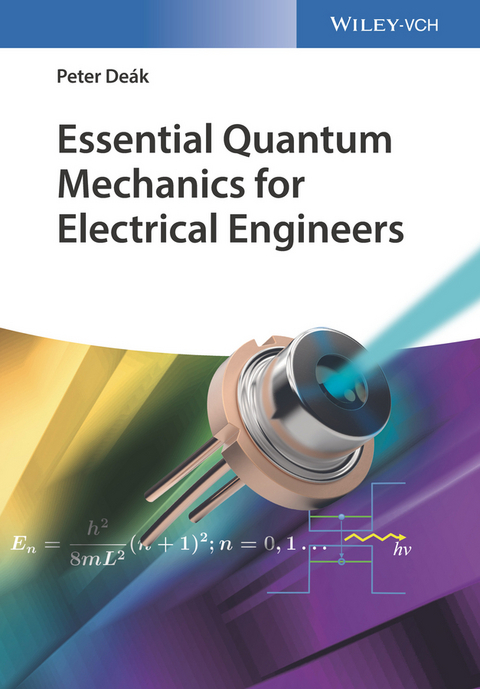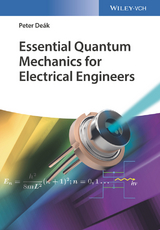Essential Quantum Mechanics for Electrical Engineers
Wiley-VCH (Verlag)
978-3-527-41355-3 (ISBN)
New developments in micro- and opto-electronics and the advent of quantum information processing will soon make the active understanding of QM unavoidable for engineers, too.
Unfortunately, the principles of QM can only be formulated mathematically, so even introductory books on the subject are mostly rather abstract. This book, written mainly for BSc students, tries to help the reader by showing "QM in action", demonstrating its surprising effects directly in applications, like lighting technology, lasers, photo- and solar cells, flash memories and quantum bits.
While the axioms and basic concepts of quantum mechanics are introduced without compromises, the math is kept at a level which is required from electrical engineers anyhow. Computational work is spared by the use of Applets which also visualize the results.
Among the host of other didactic features are learning objectives, chapter summaries, self-testing questions, and problems with solutions, while two appendices summarize the knowledge in classical physics and mathematics which is needed for this book.
Der Autor dieses Lehrbuchs ist seit über 25 Jahren Dozent für Quantenmechanik in den Fachrichtungen Elektrotechnik und Informatik. Das Fachbuch ist wissenschaftlich fundiert und gut geschrieben, überzeugt durch eine ausgewogene Darstellung notwendiger formaler Mathematik und Text.
Die Einführung fasst die Grundkonzepte der klassischen Physik zusammen und stellt einige ihrer Versäumnisse heraus, die sich aus Phänomenen in Verbindung mit der Lichttechnik ergeben. Diese werden in den darauffolgenden drei Kapiteln ausführlich analysiert.
Kapitel 5 geht über das Dualitätsprinzip hinaus und erläutert die Partikelkonzepte der Quantenmechanik sowie deren Folgen für die Elektrotechnik. In den Kapiteln 6 bis 8 werden die mathematischen Grundkonstruktionen beschrieben, mit denen sich der Zustand von Partikeln und deren Eigenschaften ableiten und vorhersagen lassen. Die beiden weiteren Kapitel zeigen zwei Beispiele hierfür mit Anwendungen von LEDs, Infrarotdetektoren, Quantenkaskadenlasern, Zener-Dioden und Flash-Speichern.
In den letzten Kapiteln werden die Folgen der Quantenmechanik für die chemischen Eigenschaften von Atomen und anderen, aus vielen Elektronen bestehenden Systemen erörtert, abgerundet durch einen kurzen Einblick in die möglichen Hardwarekomponenten für die Quanteninformationsverarbeitung.
Zu den vielfältigen didaktischen Merkmalen gehören auch Lernziele, Kapitelzusammenfassungen, Fragen zur Selbstüberprüfung sowie Problemlösungen. In den beiden Anhängen sind die notwendigen Kenntnisse der klassischen Physik und Mathematik zusammengefasst.
Peter Deák is currently Professor of Theoretical Semiconductor Physics at the University of Bremen, Germany, and head of the Electronic Materials Group in the Bremen Center of Computational Materials Science. After obtaining his PhD at the Eötvös University of Budapest, Hungary, and post-doctoral positions at SUNY, Albany, the Max Planck Institute for Solid State Research in Stuttgart and the University of Kaiserslautern, Germany, he obtained a tenure as professor of surface physics at the Budapest Institute of Technology and Economics in 1993. He relocated to Germany in 2003 where he took up his current position in Bremen. Peter Deák has more than 25 years of experience in teaching physics to undergraduates of electrical engineering and informatics.
1 INTRODUCTION. CLASSICAL PHYSICS AND THE PHYSICS OF INFORMATION TECHNOLOGY
1.1 The perception of matter in the classical physics
1.2 Axioms of the classical physics
1.3 Status and effect of the classical physics by the end of the 19th century
1.4 Physics background of the high-tech era
1.5 Developments in physics reflected by the development of lighting technology
1.6 The demand for physics in electrical engineering and informatics: today and tomorrow
1.7 Control questions and exercises
2 BLACKBODY RADIATION: THE PHYSICS OF THE INCANDESCENT LAMP AND OF THE PYROMETER
2.1 Electromagnetic radiation of heated bodies
2.2 Electromagnetic field in equilibrium with a metal cage of temperature T
2.3 Determination of the average energy per degree of freedom. Planck's law
2.4 Practical applications of Planck's law for the blackbody radiation
2.5 Significance of Planck's law for the physics
2.6 Control questions and exercises
3 PHOTONS. THE PHYSICS OF LASERS
3.1 The photoelectric effect
3.2 Practical applications of the photoelectric effect (photocell, solar cell, chemical analysis)
3.3 The Compton-Effect
3.4 The photon hypothesis of Einstein
3.5 Planck's law and the photons. Stimulated emission
3.6 The laser
3.7 Control questions and exercises
4 ELECTRONS. THE PHYSICS OF DISCHARGE LAMPS
4.1 The fluorescent lamp
4.2 Frank-Hertz-Experiment
4.3 Models of the hydrogen atom
4.4 Practical consequences of the energy quantization for discharge lamps
4.5 The de Broglie hypothesis
4.6 The Davisson - Germer Experiment
4.7 Wave - particle dualism
4.8 Control questions and exercises
5 THE PARTICLE CONCEPT OF QUANTUM MECHANICS
5.1 Particles and waves in the classical physics
5.2 Double slit experiment with a single electron
5.3 The Born - Jordan interpretation of the electron wave
5.4 Heisenberg's uncertainty principle
5.5 Particle concept of the quantum mechanics
5.6 The scale-dependence of physics
5.7 Towards a new physics
5.8 The significance of electron waves for electrical engineering
5.9 Displaying electron waves
5.10 Control questions and exercises
6 MEASUREMENT IN THE QUANTUM MECHANICS. POSTULATES 1-3
6.1 Physical restrictions for the wave function of an electron
6.2 Mathematical definitions and laws related to the wave function
6.3 Mathematical representation of the measurement by operators
6.4 Mathematical definitions and laws related to operators
6.5 Measurement in the quantum mechanics
6.6 Control questions and exercises
7 OBSERVABLES IN THE QUANTUM MECHANICS. POSTULATES 4-5. THE RELATION OF CLASSICAL AND QUANTUM MECHANICS
7.1 The canonical commutation relations of Heisenberg
7.2 The choice of operators by Schrödinger
7.3 Vector operator of the angular momentum
7.4 Energy operators and the Schrödinger equation
7.5 Time evolution of observables.
7.6 The Ehrenfest-Theorem
7.7 Control questions and exercises
8 QUANTUM MECHANICAL STATES.
8.1 Eigenstates of position
8.2 Eigenstates of momentum
8.3 Eigenstates of energy - stationary states
8.4 Free motion
8.5 Bound states
8.6 Control questions and exercises
9 THE QUANTUM WELL: THE BASIS OF MODERN LIGHT EMITTING DIODES (LEDS).
9.1 Quantum well LEDs
9.2 Energy eigenvalues in a finite quantum well
9.3 Applications in LEDs and in Detectors.
9.4 Stationary states in a finite quantum well.
9.5 The infinite quantum well
9.6 Comparison to a classical particle in a box
9.7 Control questions and exercises
10 THE TUNNEL EFFECT AND ITS ROLE IN ELECTRONICS
10.1 The scanning tunneling microscope
10.2 Electron at a potential barrier
10.3 Field emission, leakage currents, electrical breakdown, flash memories
10.4 Resonant tunneling, quantum field effect transistor, quantum cascade lasers
10.5 Control questions and exercises
11 THE HYDROGEN ATOM. QUANTUM NUMBERS. ELECTRON SPIN
11.1 Eigenstates of Lz
11.2 Eigenstates of L2
11.3 Energy eigenstates of an electron in the hydrogen atom
11.4 Angular momentum of electrons. The spin
11.5 Control questions and exercises
12 QUANTUM MECHANICS OF MANY-BODY SYSTEMS (POSTULATES 6-7). THE CHEMICAL PROPERTIES OF ATOMS, QUANTUM INFORMATION PROCESSING
12.1 The wave-function of a system of identical particles
12.2 The Pauli principle
12.3 Independent electron approximation (one-electron approximation)
12.4 Atoms with several electrons
12.5 The chemical properties of atoms
12.6 The periodic system of elements.
12.7 Significance of superposition states for the future of electronics and informatics
12.8 Control questions and exercises
APPENDIX A: IMPORTANT FORMULAS OF CLASSICAL PHYSICS
A.1 Basic concepts
A.2 Newton's axioms
A.3 Conservation laws
A.4 Examples
A.5 Waves in an elastic medium
A.6 Wave optics
A.7 Equilibrium energy distribution among many particles
A.8 Complementary variables
A.9 Special relativity theory
APPENDIX B: IMPORTANT MATHEMATICAL FORMULAS
B.1 Numbers
B.2 Calculus
B.3 Operators
B.4 Differential equations
B.5 Vectors and Matrices
Solutions
| Erscheinungsdatum | 13.04.2017 |
|---|---|
| Verlagsort | Berlin |
| Sprache | englisch |
| Maße | 170 x 244 mm |
| Gewicht | 498 g |
| Einbandart | Paperback |
| Themenwelt | Mathematik / Informatik ► Informatik ► Theorie / Studium |
| Naturwissenschaften ► Physik / Astronomie ► Quantenphysik | |
| Naturwissenschaften ► Physik / Astronomie ► Theoretische Physik | |
| Technik ► Elektrotechnik / Energietechnik | |
| Schlagworte | Allg. Informatik • Computer Science • Electrical & Electronics Engineering • Electrical & Electronics Engineering • Elektroingenieur • Elektrotechnik u. Elektronik • Informatik • Informationstechnologie • Information Technologies • Physics • Physik • Quantenelektronik • Quantenmechanik • Quantenmechanik; Handbuch/Lehrbuch • Quantenphysik • Quantenphysik u. Feldtheorie • Quantum Electronics • Quantum Physics & Field Theory • Quantum Physics & Field Theory |
| ISBN-10 | 3-527-41355-3 / 3527413553 |
| ISBN-13 | 978-3-527-41355-3 / 9783527413553 |
| Zustand | Neuware |
| Haben Sie eine Frage zum Produkt? |
aus dem Bereich




